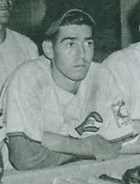- Posts: 15159
- Joined: Thu Aug 23, 2012 10:42 pm
Veterans Day
As Veterans Day approaches, I thought I would share a few stories regarding some of our well-known ATG players, and some that may be less used and well-known, as they took part in military service.
HUGH MULCAHY
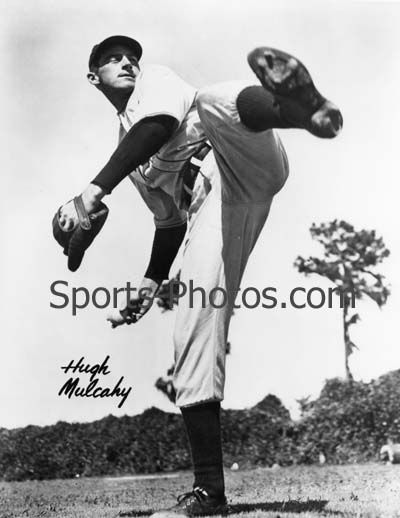
One guy I have actually used before, Hugh Mulcahy holds the distinction of being the first major league regular to be drafted in World War II. Hugh "Losing Pitcher" Mulcahy - a veteran with the Philadelphia Phillies - was inducted on March 8, 1941, and reported to Camp Devens, Massachusetts. The 27-year-old right-hander earned his nickname by losing 76 games between 1937 and 1940 as a starter with the senior circuit's perennial basement team. Mulcahy proudly told The Sporting News, "My losing streak is over for the duration ... I'm on a winning team now."
BOB FELLER
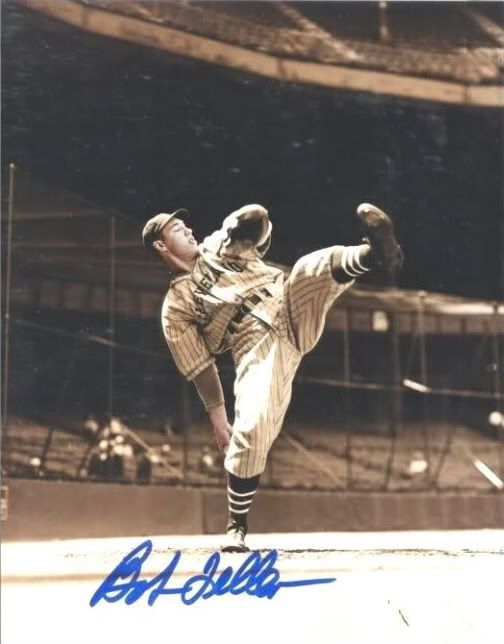
On December 8, 1941 Feller enlisted in the Navy, volunteering immediately for combat service, becoming the first Major League Baseball player to do so following the Attack on Pearl Harbor on December 7. Feller served as Gun Captain aboard the USS Alabama, and missed four seasons during his service in World War II, being decorated with five campaign ribbons and eight battle stars. His bunk is marked on the Alabama at Battleship Memorial Park in Mobile, Alabama. Feller is the only Chief Petty Officer in the Baseball Hall of Fame. On vacation two years ago, my family toured the USS Alabama battleship in Mobile Bay and saw Feller's bunk...........
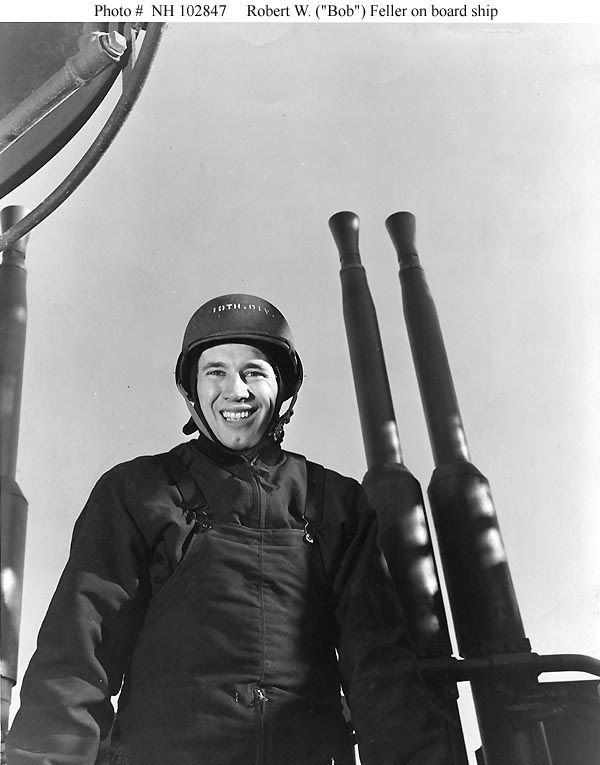
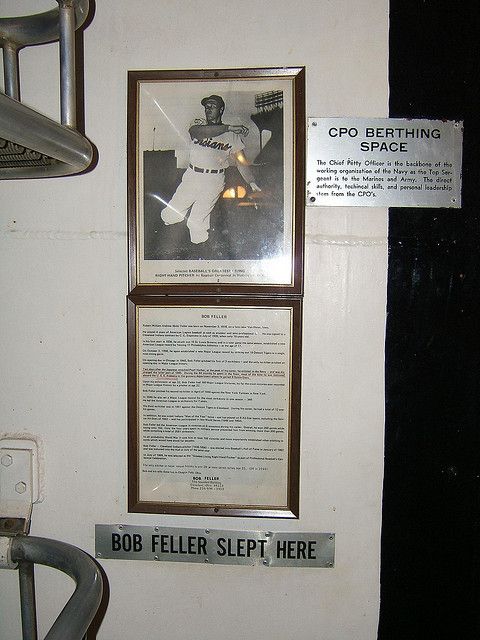
MOE BERG

Moe Berg is a .50 catcher in ATG, but he played more than a backup role in World War II. Berg graduated Princeton with a degree in modern languages having studied Latin, Greek, French, Spanish, Italian, German and Sanskrit. This later inspired the observation by Chicago White Sox teammate, Ted Lyons, that "he can speak twelve languages but can't hit in any of them." He signed with Brooklyn, then played for the White Sox as backup for Ray Schalk.
During the winter of 1932, Berg, along with Lefty O'Doul, and Ted Lyons, went to teach baseball seminars at Japanese universities When the other Americans returned to the United States after their coaching assignments were over, Berg stayed behind to explore Japan. He went on to tour Manchuria, Shanghai, Peking, Indochina, Siam, India, Egypt and Berlin.
He returned to Japan in 1934 as part of an all-star group of players, including Babe Ruth, Lou Gehrig, Earl Averill, Charlie Gehringer, Jimmie Foxx and Lefty Gomez. Despite Berg being a mediocre, third-string catcher, he was invited at the last minute to make the trip. He had with him a 16-mm movie camera and gave a welcome speech in Japanese upon the all-stars’ arrival.
On November 29, 1934, while the rest of the team was playing in Omiya, Berg went to Saint Luke's Hospital in Tsukiji. Berg went up on the roof of the hospital - one of the tallest buildings in Tokyo - and filmed the city and harbor with his movie camera.
Berg then played 5 seasons as a backup for the Red Sox, then coached for Boston in 1940 and 1941.
Following the Japanese attack on Pearl Harbor, Berg accepted a position with the Office of Inter-American Affairs on January 5, 1942. During the summer of that year, he screened the footage he shot of Tokyo Bay for military intelligence officers.
From August 1942 until February 1943, Berg was on assignment in the Caribbean and South America. His job was to monitor the health and physical fitness of the American troops stationed there. Berg, along with several other OIAA agents, left in June 1943 because they thought South America posed little threat to the United States, and they wanted to be where their talents would be put to better use.
On August 2, 1943, Berg accepted a position with the Office of Strategic Services. In September, he was assigned to the Secret Intelligence branch of the OSS and given a place at the OSS Balkans desk. In this role, he parachuted into Yugoslavia to evaluate the various resistance groups operating against the Nazis to determine which was the strongest. His evaluations were used to help determine the amount of support and aid to give each group.
In late 1943, Berg was assigned to Project Larson, an OSS operation set up by OSS Chief of Special Projects John Shaheen. The stated purpose of the project was to kidnap Italian rocket and missile specialists out of Italy and bring them to the United States. However, there was another project hidden within Larson called Project AZUSA with the goal of interviewing Italian physicists to see what they knew about Werner Heisenberg and Carl Friedrich von Weizsäcker. It was similar in scope and mission to the Alsos project. On May 4, 1944 Berg left for London and the start of his mission.
From May to mid-December, Berg hopped around Europe interviewing physicists and trying to convince several to leave Europe and work in America. Despite Berg's wartime vocation calling for anonymity, he did betray himself on one occasion. While at a field hospital in France, Berg could not resist the temptation to join in a game of catch with a couple of GIs. After the former major leaguer had made a couple of throws one of the soldiers remarked, "You're a pro." Soon afterwards the soldier added, "You're a catcher," another throw and his cover was blown, "and your name is Moe Berg."
At the beginning of December, Berg attended a lecture by prominent German physicist Werner Heisenberg. His orders were to kill the scientist if there was any indication that the Germans were close to building an atomic bomb. Fortunately, Berg was not required to fulfill his orders as the Germans were far behind in the race to build an atomic weapon.
Berg returned to the United States on April 25, 1945, and resigned from the Strategic Services Unit - the successor to the OSS - in August. He was awarded the Presidential Medal of Freedom on October 10, 1945 but he rejected the award. Some years after his death, the award was accepted on his behalf by his sister.
LOU BRISSIE
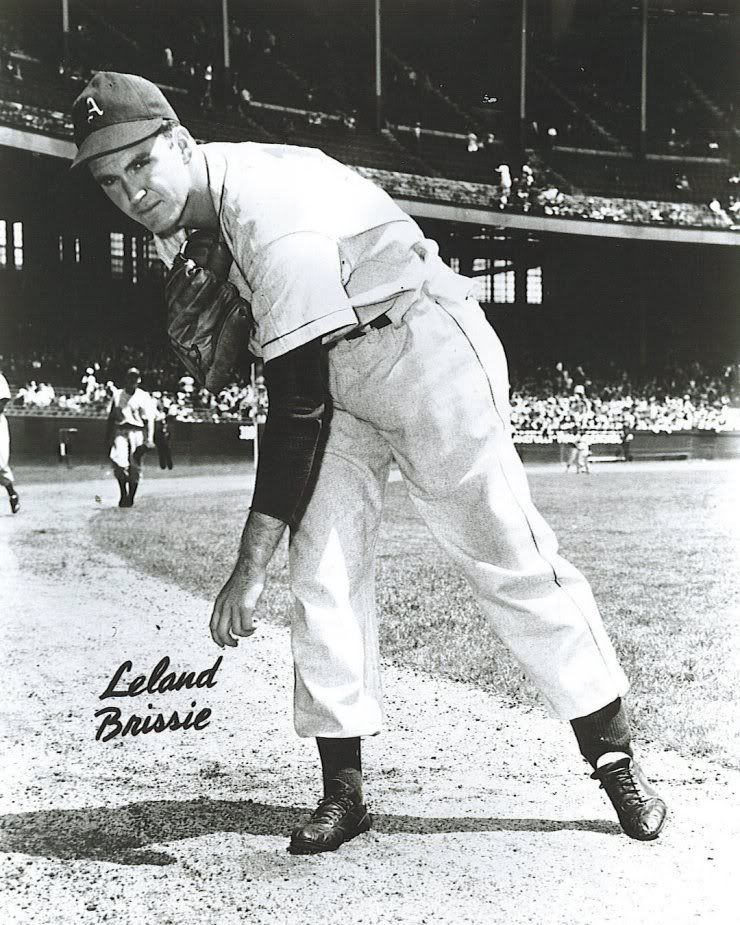
Lou Brissie began his baseball career in 1940 when at the age of 16 he pitched for Ware Shoales in a textile baseball league. Lou attracted the attention of Connie Mack and the Philadelphia Athletics in 1941; however his father insisted he finish school.
Lou attended Presbyterian College before enlisting in the U.S. Army in December 1942. Later that year, Corporal Brissie was sent to Italy with the 88th Infantry Division. He served as a squad leader with G Company of the 351st Infantry Regiment. On December 7, 1944, Brissie's squad was hit by a fierce artillery attack in the Apennine Mountains in northern Italy. "Our unit suffered over 90 percent casualties," Brissie said. "Within minutes we lost three of our four officers as well as eight other men in the barrage," he recalled. Brissie was badly hit. His left shinbone was shattered in more than 30 pieces and his left ankle and right foot were broken. He had to crawl for cover through the mud and then lay there unconscious until he was found hours later. Brissie was rushed to a field hospital where his leg should have been amputated, but somehow he was able to persuade the doctors to ship him to an evacuation hospital where the limb might be saved. He was finally sent to a military hospital in Naples where Captain Wilbur Brubaker set about saving the young soldier’s leg. “Captain Brubaker did a marvelous job,” Brissie said. “Once he operated on me, I didn’t wonder if I could make it back to pitch but how I could do it. I felt like the good Lord put Dr Brubaker in my life. I really felt that God put me on the path that took me to all those hospitals over that three-day period to get me to someone who could help me.”
Lou's citations included the Purple Heart (with oak leaf cluster), Bronze Star, ETO and American Campaign Medals.
After 2 years and 23 major operations Lou was able to return to baseball with a metal brace on his leg. He was signed by the Philadelphia A's on December 15, 1946. His comeback began with Savannah in the Southern League where he won 25 games in 1947. The A's called him up and on September 28th, 1947 he realized his "life's ambition" of pitching in the major leagues.
His best seasons with the A's came in 1948 when was 14-10, and 1949 when he was 16-11. He pitched 3 innings for the 1949 American League All Star team.
Today Brissie, 88, lives in North Augusta, S.C. Following his career in baseball, Brissie became the national director of the American Legion baseball program for many years.
He may not have that great a Strat card, but he is a true American hero. Maybe if you create a team this Veterans Day , you can find a way to make Brissie your #4 starter.
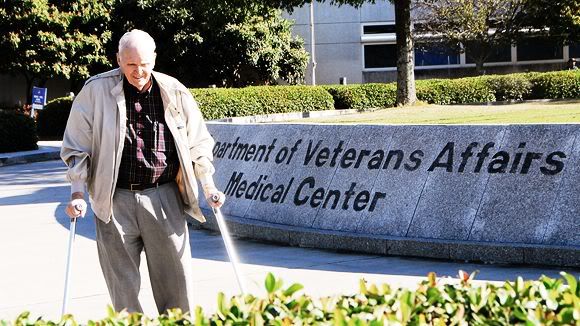
As Veterans Day approaches, I thought I would share a few stories regarding some of our well-known ATG players, and some that may be less used and well-known, as they took part in military service.
HUGH MULCAHY

One guy I have actually used before, Hugh Mulcahy holds the distinction of being the first major league regular to be drafted in World War II. Hugh "Losing Pitcher" Mulcahy - a veteran with the Philadelphia Phillies - was inducted on March 8, 1941, and reported to Camp Devens, Massachusetts. The 27-year-old right-hander earned his nickname by losing 76 games between 1937 and 1940 as a starter with the senior circuit's perennial basement team. Mulcahy proudly told The Sporting News, "My losing streak is over for the duration ... I'm on a winning team now."
BOB FELLER

On December 8, 1941 Feller enlisted in the Navy, volunteering immediately for combat service, becoming the first Major League Baseball player to do so following the Attack on Pearl Harbor on December 7. Feller served as Gun Captain aboard the USS Alabama, and missed four seasons during his service in World War II, being decorated with five campaign ribbons and eight battle stars. His bunk is marked on the Alabama at Battleship Memorial Park in Mobile, Alabama. Feller is the only Chief Petty Officer in the Baseball Hall of Fame. On vacation two years ago, my family toured the USS Alabama battleship in Mobile Bay and saw Feller's bunk...........


MOE BERG

Moe Berg is a .50 catcher in ATG, but he played more than a backup role in World War II. Berg graduated Princeton with a degree in modern languages having studied Latin, Greek, French, Spanish, Italian, German and Sanskrit. This later inspired the observation by Chicago White Sox teammate, Ted Lyons, that "he can speak twelve languages but can't hit in any of them." He signed with Brooklyn, then played for the White Sox as backup for Ray Schalk.
During the winter of 1932, Berg, along with Lefty O'Doul, and Ted Lyons, went to teach baseball seminars at Japanese universities When the other Americans returned to the United States after their coaching assignments were over, Berg stayed behind to explore Japan. He went on to tour Manchuria, Shanghai, Peking, Indochina, Siam, India, Egypt and Berlin.
He returned to Japan in 1934 as part of an all-star group of players, including Babe Ruth, Lou Gehrig, Earl Averill, Charlie Gehringer, Jimmie Foxx and Lefty Gomez. Despite Berg being a mediocre, third-string catcher, he was invited at the last minute to make the trip. He had with him a 16-mm movie camera and gave a welcome speech in Japanese upon the all-stars’ arrival.
On November 29, 1934, while the rest of the team was playing in Omiya, Berg went to Saint Luke's Hospital in Tsukiji. Berg went up on the roof of the hospital - one of the tallest buildings in Tokyo - and filmed the city and harbor with his movie camera.
Berg then played 5 seasons as a backup for the Red Sox, then coached for Boston in 1940 and 1941.
Following the Japanese attack on Pearl Harbor, Berg accepted a position with the Office of Inter-American Affairs on January 5, 1942. During the summer of that year, he screened the footage he shot of Tokyo Bay for military intelligence officers.
From August 1942 until February 1943, Berg was on assignment in the Caribbean and South America. His job was to monitor the health and physical fitness of the American troops stationed there. Berg, along with several other OIAA agents, left in June 1943 because they thought South America posed little threat to the United States, and they wanted to be where their talents would be put to better use.
On August 2, 1943, Berg accepted a position with the Office of Strategic Services. In September, he was assigned to the Secret Intelligence branch of the OSS and given a place at the OSS Balkans desk. In this role, he parachuted into Yugoslavia to evaluate the various resistance groups operating against the Nazis to determine which was the strongest. His evaluations were used to help determine the amount of support and aid to give each group.
In late 1943, Berg was assigned to Project Larson, an OSS operation set up by OSS Chief of Special Projects John Shaheen. The stated purpose of the project was to kidnap Italian rocket and missile specialists out of Italy and bring them to the United States. However, there was another project hidden within Larson called Project AZUSA with the goal of interviewing Italian physicists to see what they knew about Werner Heisenberg and Carl Friedrich von Weizsäcker. It was similar in scope and mission to the Alsos project. On May 4, 1944 Berg left for London and the start of his mission.
From May to mid-December, Berg hopped around Europe interviewing physicists and trying to convince several to leave Europe and work in America. Despite Berg's wartime vocation calling for anonymity, he did betray himself on one occasion. While at a field hospital in France, Berg could not resist the temptation to join in a game of catch with a couple of GIs. After the former major leaguer had made a couple of throws one of the soldiers remarked, "You're a pro." Soon afterwards the soldier added, "You're a catcher," another throw and his cover was blown, "and your name is Moe Berg."
At the beginning of December, Berg attended a lecture by prominent German physicist Werner Heisenberg. His orders were to kill the scientist if there was any indication that the Germans were close to building an atomic bomb. Fortunately, Berg was not required to fulfill his orders as the Germans were far behind in the race to build an atomic weapon.
Berg returned to the United States on April 25, 1945, and resigned from the Strategic Services Unit - the successor to the OSS - in August. He was awarded the Presidential Medal of Freedom on October 10, 1945 but he rejected the award. Some years after his death, the award was accepted on his behalf by his sister.
LOU BRISSIE

Lou Brissie began his baseball career in 1940 when at the age of 16 he pitched for Ware Shoales in a textile baseball league. Lou attracted the attention of Connie Mack and the Philadelphia Athletics in 1941; however his father insisted he finish school.
Lou attended Presbyterian College before enlisting in the U.S. Army in December 1942. Later that year, Corporal Brissie was sent to Italy with the 88th Infantry Division. He served as a squad leader with G Company of the 351st Infantry Regiment. On December 7, 1944, Brissie's squad was hit by a fierce artillery attack in the Apennine Mountains in northern Italy. "Our unit suffered over 90 percent casualties," Brissie said. "Within minutes we lost three of our four officers as well as eight other men in the barrage," he recalled. Brissie was badly hit. His left shinbone was shattered in more than 30 pieces and his left ankle and right foot were broken. He had to crawl for cover through the mud and then lay there unconscious until he was found hours later. Brissie was rushed to a field hospital where his leg should have been amputated, but somehow he was able to persuade the doctors to ship him to an evacuation hospital where the limb might be saved. He was finally sent to a military hospital in Naples where Captain Wilbur Brubaker set about saving the young soldier’s leg. “Captain Brubaker did a marvelous job,” Brissie said. “Once he operated on me, I didn’t wonder if I could make it back to pitch but how I could do it. I felt like the good Lord put Dr Brubaker in my life. I really felt that God put me on the path that took me to all those hospitals over that three-day period to get me to someone who could help me.”
Lou's citations included the Purple Heart (with oak leaf cluster), Bronze Star, ETO and American Campaign Medals.
After 2 years and 23 major operations Lou was able to return to baseball with a metal brace on his leg. He was signed by the Philadelphia A's on December 15, 1946. His comeback began with Savannah in the Southern League where he won 25 games in 1947. The A's called him up and on September 28th, 1947 he realized his "life's ambition" of pitching in the major leagues.
His best seasons with the A's came in 1948 when was 14-10, and 1949 when he was 16-11. He pitched 3 innings for the 1949 American League All Star team.
Today Brissie, 88, lives in North Augusta, S.C. Following his career in baseball, Brissie became the national director of the American Legion baseball program for many years.
He may not have that great a Strat card, but he is a true American hero. Maybe if you create a team this Veterans Day , you can find a way to make Brissie your #4 starter.

